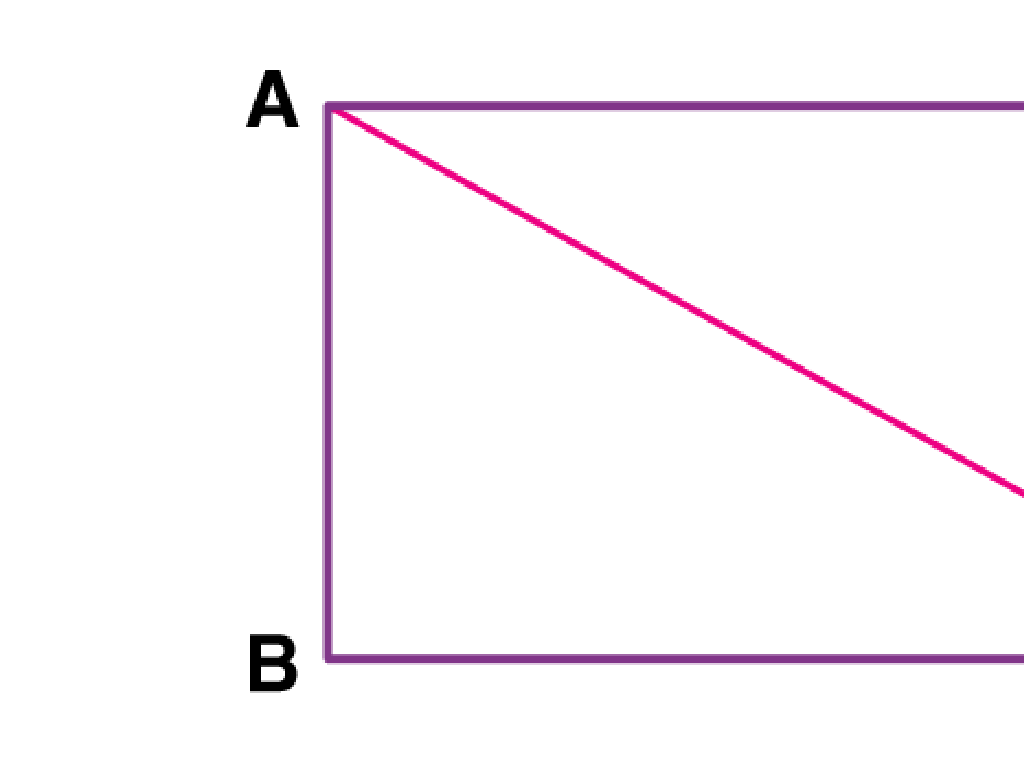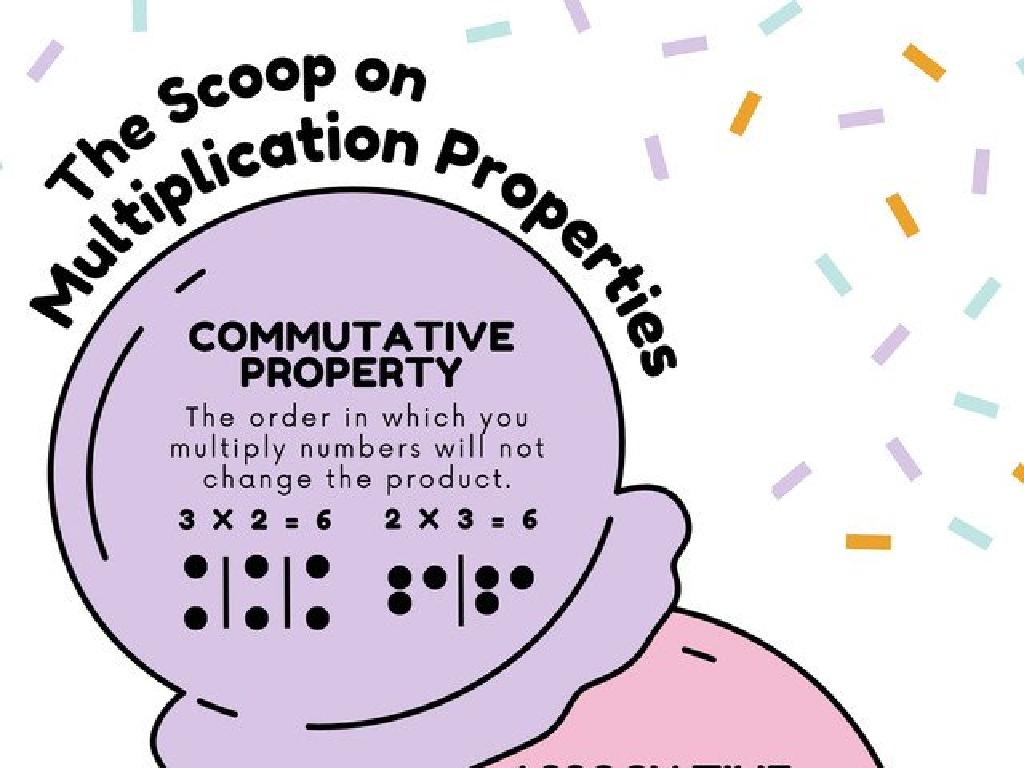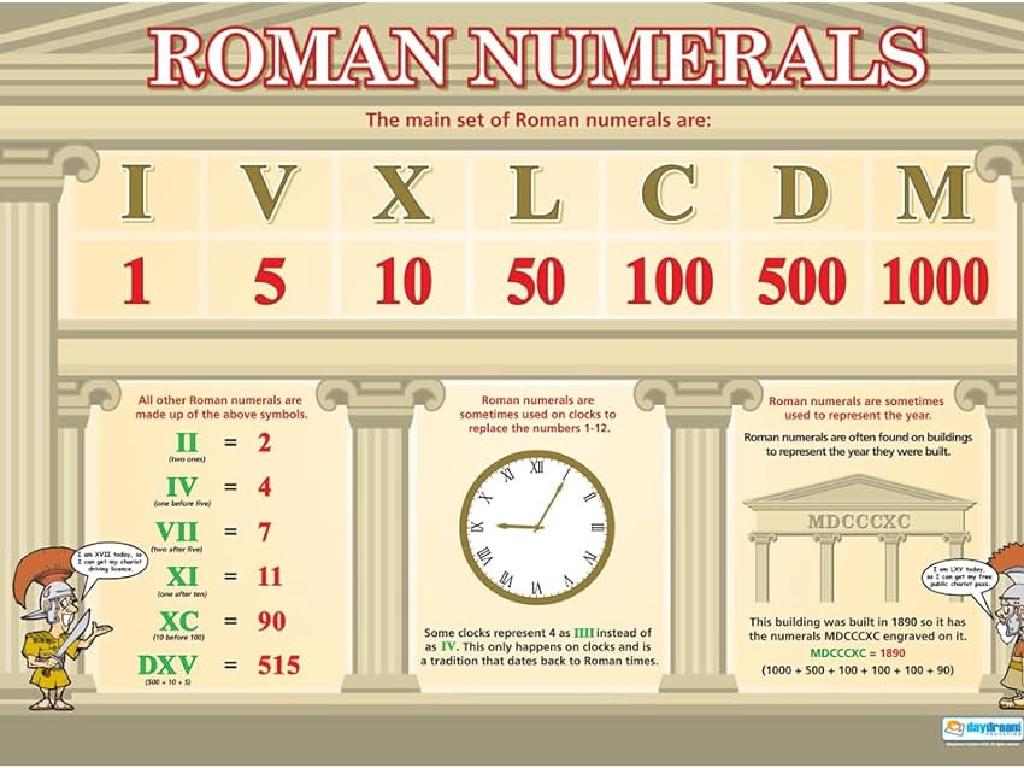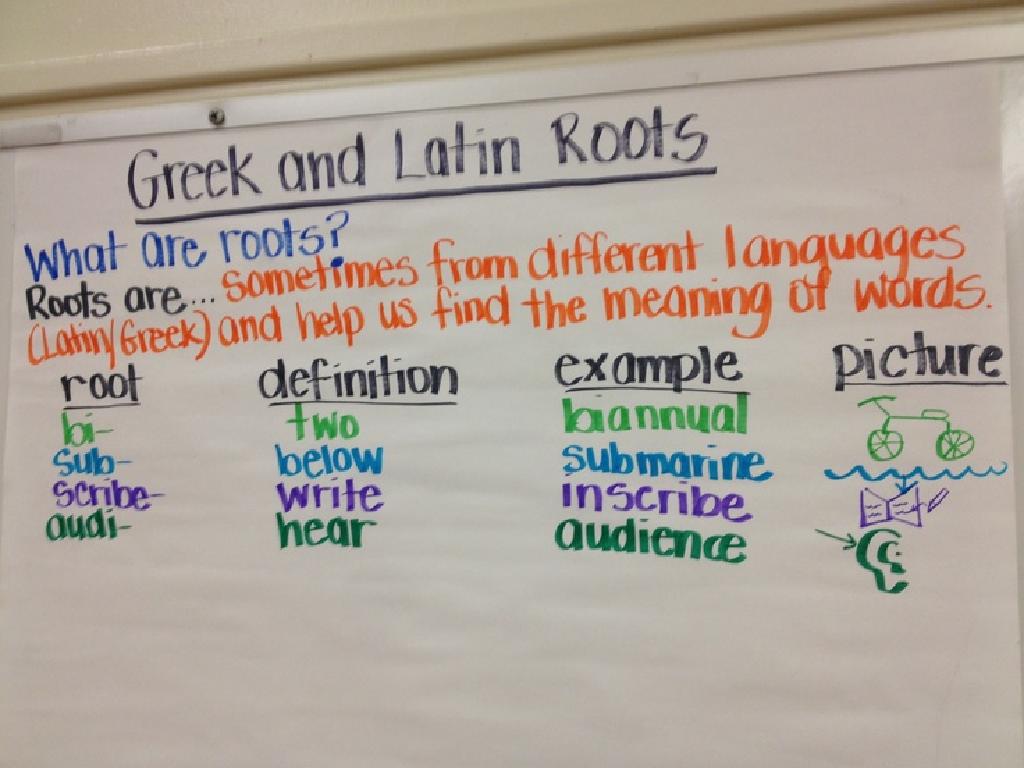Lines, Line Segments, And Rays
Subject: Math
Grade: Seventh grade
Topic: Lines And Angles
Please LOG IN to download the presentation. Access is available to registered users only.
View More Content
Exploring Geometry: Lines, Segments, and Rays
– Differentiating lines, segments, and rays
– Lines are endless, segments have fixed points, rays start at a point and extend infinitely.
– Grasping basic geometric concepts
– Understand terms like endpoints and how they define each figure.
– Observing geometry in everyday life
– Notice shapes, structures, and paths that use these elements.
– Applying knowledge to real-world problems
– Use these concepts to solve practical problems and puzzles.
|
This slide introduces students to the fundamental elements of geometry: lines, line segments, and rays. It’s crucial to explain that while lines are infinite in both directions, line segments have two distinct endpoints, and rays extend infinitely in one direction from a starting point. Encourage students to observe these elements in the world around them, such as the edges of a book (segment), the beam of a flashlight (ray), or the horizon (line). Discuss how understanding these concepts is not only key to geometry but also applicable in solving real-world problems, such as in construction, art, and navigation.
Exploring Lines in Geometry
– Definition of a line
– A line is a straight one-dimensional figure with no thickness and extends endlessly in both directions.
– Lines are straight paths
– Unlike line segments, lines don’t curve or bend.
– No endpoints in lines
– Lines extend infinitely
– Imagine a line as a series of points that goes on forever in both directions.
|
This slide introduces the concept of a line in the context of geometry. A line is one of the most fundamental elements in geometry, defined as a straight one-dimensional figure that has no thickness and extends infinitely in both directions. It’s important to distinguish lines from line segments, which are portions of lines that do have endpoints. Emphasize that lines are abstract concepts that we represent visually with arrows on both ends to indicate their infinite nature. Encourage students to visualize lines as a series of points that are so close together they form a straight path, and to understand that these points continue without end.
Exploring Line Segments
– Define a line segment
– A line segment is part of a line between two endpoints
– Line segments end with points
– Unlike lines, segments stop at two points
– Measuring line segment length
– Use a ruler to measure the distance between endpoints
|
A line segment is a basic geometric concept where it is defined as a part of a line that is bounded by two distinct end points, and contains every point on the line between its endpoints. This differs from a line which extends infinitely in both directions. Emphasize that line segments are named by their endpoints and that the length of a line segment is the distance between its endpoints, which can be measured using a ruler or a measuring tape. This concept is fundamental in understanding geometry and will be used in various applications as students progress in math.
Exploring Rays in Geometry
– Define a ray in geometry
– A ray starts at a point and goes on forever in one direction
– Rays: One endpoint, infinite extension
– Imagine a sunbeam: starts at the sun (endpoint) and travels outward endlessly
– Rays vs. lines and segments
– Unlike a line, a ray doesn’t extend both ways; unlike a segment, it’s not finite
– Understanding rays with examples
– Example: Sun’s rays, a laser beam
|
This slide introduces the concept of rays within the broader topic of lines and angles. A ray is a fundamental geometric concept characterized by having a single fixed endpoint and extending infinitely in one direction. It’s crucial to differentiate between a ray, a line, and a line segment. A line has no endpoints and extends infinitely in both directions, while a line segment has two endpoints and is finite. Use real-world examples like the sun’s rays or a laser beam to help students visualize and understand the concept. Encourage students to draw their own rays and compare them with lines and line segments to solidify their understanding.
Identifying Lines, Segments, and Rays
– Examine various examples
– Look at examples to identify each type
– Discuss characteristics with a partner
– Explain why an example is a line, segment, or ray
– Class activity: drawing on the board
– Draw and label your examples in front of the class
– Understand lines, segments, and rays
|
This slide is designed to engage students in learning about lines, line segments, and rays through collaborative and interactive activities. Begin by showing different geometric figures and ask students to identify which are lines, which are line segments, and which are rays. Encourage them to discuss with a partner the defining characteristics of each, such as lines being infinite in both directions, segments having two endpoints, and rays starting at a point and extending infinitely in one direction. The class activity involves students drawing their own examples on the board, which helps reinforce their understanding and allows for immediate feedback. The teacher should circulate to provide guidance and ensure that each student can correctly identify and explain the differences between lines, line segments, and rays. Possible activities include drawing a line and marking it to show a segment and a ray, or identifying these elements in letters of the alphabet drawn on the board.
Real-World Applications of Lines and Segments
– Classroom objects as examples
– Desks, pencils, and rulers have line segments
– Use in architecture and engineering
– Architects design buildings using geometric principles
– Group activity: sketch real-world examples
– Find objects that represent lines, segments, and rays
– Understanding practical relevance
|
This slide aims to help students recognize lines, line segments, and rays in everyday objects, emphasizing their practical applications. By identifying these elements in classroom items like desks and pencils, students can relate abstract concepts to tangible items. Highlight how architects and engineers use these concepts to create blueprints and structures, reinforcing the importance of geometry in real-world professions. The group activity encourages collaborative learning and hands-on engagement. Students will work together to find and sketch examples of lines, line segments, and rays, fostering a deeper understanding of these concepts through observation and creativity. Provide guidance on how to identify and differentiate between these elements in various objects.
Practice Time: Exploring Lines and Rays
– Solve individual practice problems
– Discuss answers with the class
– Explain your problem-solving process
– How did you determine if it was a line, segment, or ray?
– Receive teacher’s feedback
– Look for patterns and strategies that can help others
|
This slide is designed to engage students in active practice of identifying and differentiating between lines, line segments, and rays. Students should work on a set of problems that challenge them to apply their knowledge individually. Afterward, they will share their answers with the class to foster a collaborative learning environment. Encouraging students to explain their reasoning helps to deepen their understanding and allows the teacher to correct any misconceptions. As students discuss, the teacher should listen actively, provide constructive feedback, and offer additional examples to clarify any confusion. This activity not only reinforces the concepts but also enhances communication and critical thinking skills.
Class Activity: Geometric String Art
– Create lines with string on paper
– Form art using geometric concepts
– Use lines, segments, and rays in a creative design
– Present artwork to the class
– Explain geometric elements used
– Identify and describe each geometric element in your art
|
This activity is designed to reinforce the concepts of lines, line segments, and rays by integrating them into a creative art project. Provide students with string, paper, and other art materials. Encourage them to use these materials to create a piece of art that incorporates the geometric concepts learned. Once completed, each student will present their artwork to the class, explaining how they used lines, segments, and rays in their design. This will help students to visualize and understand the geometric concepts in a tangible way. Possible variations of the activity could include using different colors for different types of lines, creating a collaborative mural, or challenging students to represent a scene or object using only the geometric elements discussed.
Conclusion: Lines, Segments, and Rays
– Recap: lines, segments, rays
– Why they matter in geometry
Understanding these is crucial for further geometric concepts.
– Homework: worksheet task
Identify and draw different lines, segments, and rays.
– Practice makes perfect
|
As we wrap up today’s lesson, it’s important to review the definitions and properties of lines, line segments, and rays. These foundational elements are vital for understanding more complex geometric shapes and theorems. For homework, students are expected to complete a worksheet that will reinforce their ability to identify and draw these different elements. This practice will not only solidify their comprehension but also prepare them for upcoming topics in geometry. Encourage students to approach the worksheet with the same attentiveness they’ve shown in class, and remind them that mastering these basics is key to their success in mathematics.






